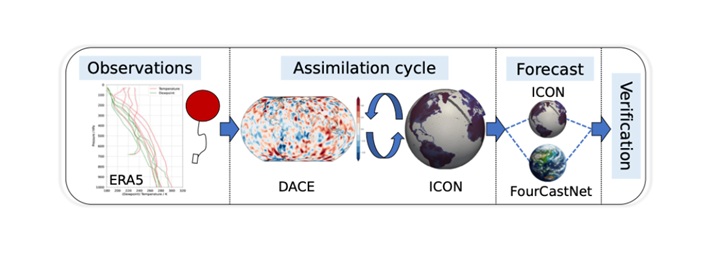A testbed to explore weather prediction in times of AI
In the past five years, new weather prediction models and Machine Learning (ML) have substantially changed the way we do weather forecasting. Meteorological services worldwide are increasingly using ML to improve their weather prediction systems. An example for this can be found at www.kit-weather.de (Pangu-ICON comparison maps). This change presents new challenges and opportunities for meteorologists in universities and research centers, as they need to work more closely with mathematics and computer science to keep up with the latest methodological developments, update their teaching curricula to reflect the new techniques and create new research facilities and strategies.
To better cope with this new situation, scientists from the KIT’s Institute of Meteorology and Climate Research Troposphere Research (IMKTRO) and the German Meteorological Service (DWD) created a new global testbed called TEEMLEAP (“TEstbed for Exploring Machine LEarning in Atmospheric Prediction”) to explore new approaches to weather forecasting in a systematic way. As shown by the figure below, the system contains key elements of an operational weather service (observations, data assimilation, forecast and verification) but in a simplified, easy‐to‐handle and ‐understand set‐up. In addition to conventional methods (i.e. DWD’s ICON numerical weather prediction model), the new ML model FourCastNet is already implemented. The testbed helps studying important issues like improving observation systems, understanding forecast uncertainties, and creating hybrid systems that combine ML with traditional models.
The TEEMLEAP testbed concept has been documented in a new article by Wilhelm et al. (2025) in the Journal of Advances in Modeling Earth Systems. It explains how the testbed works, shows a pilot experiment, and discusses examples of possible use. Future plans include applying the test bed for education in the framework of a recently funded „Research Infrastructures in Research-Oriented Teaching (RI-RO Teaching)“ project and developing a more detailed regional version that can be used for the assimilation of observations from field campaigns, e.g. IMKTRO’s world-leading observational platform KITcube.
Reference
Wilhelm, J., Quinting, J., Burba, M., Hollborn, S., Ehret, U., Pena Sánchez, I., Lerch, S., Verfürth, B., and Knippertz, P., 2025: TEEMLEAP — A new testbed for exploring machine learning in atmospheric prediction for research and education. Journal of Advances in Modeling Earth Systems, 17, e2024MS004881, doi:10.1029/2024MS004881. (Preprint: https://doi.org/10.22541/essoar.173482059.96151727/v1)

